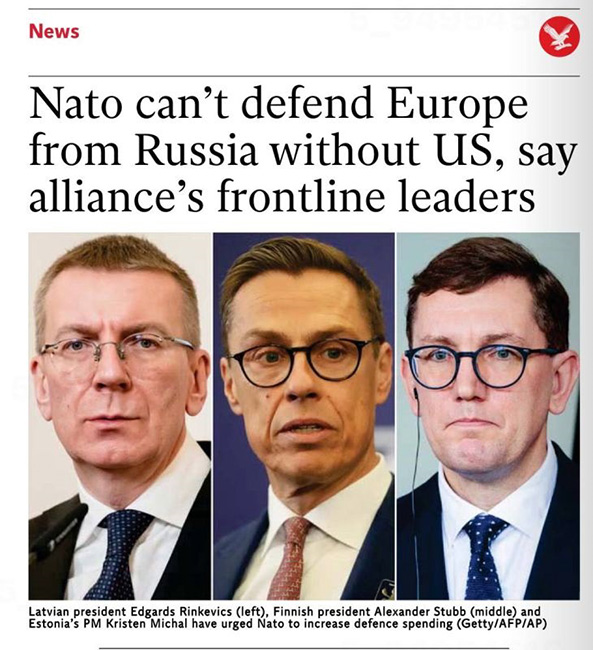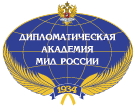
NATO is “not ready” to fight against Russia without the US, the leaders of the alliance’s three frontline states have told The Independent, as they called on allies to drastically increase defence spending, writes ‘The Independent’.
In the wake of Donald Trump’s victory in the US presidential election, the leaders of Latvia, Estonia and Finland have urged the alliance to stop “endlessly debating” how to cope with the looming threat of Russia, saying it is time to bolster Europe’s defences.
“We are not ready. That’s absolutely clear,” says Latvia president Edgars Rinkevics. “We can’t keep simply hoping for a situation where the US remains much involved in Europe.”
“We have to ramp up our defence capabilities,” Estonian prime minister Kristen Michal adds, “because of Russia’s threat, and its inability to be a democracy and operate in a rule-based world”.
The three countries are the only Nato members that border Russia, a frontier that runs for 1,200 miles from the northern tip of Finland down to the southeastern corner of Latvia.
Finland, Estonia and Latvia are also among Nato’s biggest spenders on defence relative to their gross domestic product (GDP).
NATO requires its member states to spend at least 2 per cent of its GDP on defence, but before this year only a third of countries were fulfilling this. That figure has risen to two thirds of NATO members but experts still caution that spending is too low. Russia is projected to spend 6.3 per cent of its GDP on defence by the first quarter of 2025.
Estonia spends 3.4 per cent of its GDP on defence, which is the second-highest in the alliance behind Poland. Latvia spends 3.15 per cent, making it the fourth-largest spender behind the US, and Finland spends just over 2.4 per cent.
The UK is ninth, spending 2.3 per cent, with the Labour government pledging to increase that to 2.5 per cent. But this figure belies the fact that the UK’s defence spending relative to GDP has remained relatively flat since 2014. Estonia, Finland and Latvia have all roughly doubled their spending in that time.
The need for Europe to increase its investment in defence predates the re-election of Mr Trump, but the return of the Republican billionaire to the White House has brought into sharp relief the poorly armed state of many of Europe’s NATO members, particularly in the western half of the continent.
At the start of 2024, the soon-to-be 47th US president said he would encourage Russia to “do whatever the hell they want” to NATO members who do not pay their fair share into the Western military alliance.
That drew criticism for undermining NATO’s Article 5, which states that an attack on one is an attack on all, but Mr Stubb praised what he described as “pressure” from Mr Trump, though he urged the alliance to focus “more on capabilities rather than expenditure”.
“Everyone needs to correct their defence deficit,” he says, adding that Europe should compensate for the Cold War mentality of downgrading military capabilities. On the issue of future US involvement in the alliance, he says: “I don't think that we can have Nato without the United States.”
Mr Rinkevics says there are discussions in progress about raising the minimum mandated spending level of NATO members to 2.5 per cent.
During a meeting of European leaders in the Estonian capital Tallinn in December, the country’s defence minister Hanno Pevkur argued Nato member states should be spending as much as five per cent.
While none of the European leaders said they believed Mr Trump would pull out of NATO, his long-held scepticism of the alliance notwithstanding, concerns prevail that the US, particularly under the incoming president, will eventually look to shift attention to China and the Indo-Pacific, including the defence of Taiwan.
“Their number one nemesis or competitor is China,” says Mr Stubb, though he adds that he believes Mr Trump nevertheless understands the importance of alliances in combating Beijing, too.
Experts have also pointed out that should the US shift its resources and focus too quickly to the Indo-Pacific without affording Europe time to become more independent, they could be dragged back into European security issues at a much greater expense.
But the inability of Europe to protect itself, particularly without the US, only emphasises its difficulty in continuing to support Ukraine militarily.
“We are training Ukrainians together with Estonians and Finns, but at this point, the capacity is not enough,” admits Mr Rinkevics.
“I would say that currently one of the issues is not only that many nations are not ready to provide Ukraine with arms, it’s the defence industry that is not able to produce at the necessary level. We can provide Ukraine with what we can, but in many cases, we are already at the edge of what we have.”
read more in our Telegram-channel https://t.me/The_International_Affairs

 11:43 27.12.2024 •
11:43 27.12.2024 •






















